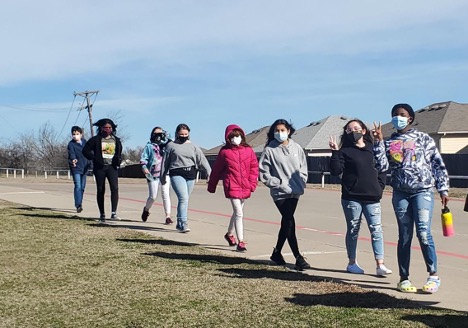
Address Learning Loss In Afterschool With This Simple, ESSER-Aligned Program
To help students catch up on lost instructional time during the pandemic, schools and afterschool programs are taking advantage of Elementary and Secondary School Emergency Relief (ESSER) funding to implement new learning programs. Key to those efforts is finding programming that aligns with ESSER funding requirements but that is also easy to use, effective, and fun for students.
While ESSER addresses aspects that relate to all students, the requirements for summer learning, enrichment, and supplemental programs address afterschool specifically. The Walking Classroom (TWC) aligns to those requirements and is used throughout the U.S. to support academic enrichment and curriculum in afterschool.
Helen Bocook, a 21st CCLC director in Kentucky said, “We have used TWC in afterschool. We have partnered with the school day teacher to find out what they are studying in class, especially preparing for testing. The students use TWC during our tutoring time. The students absolutely love it. With the learning loss that every student and school experienced due to the pandemic, we were lucky to have The Walking Classroom as a resource that students not only needed for learning but also loved to use.”
The Walking Classroom is simple: Students take a brisk walk while listening to standards-aligned, educational podcasts that are supported by lesson plans, comprehension quizzes, and supplemental activities. The evidence-based program includes podcasts on English language arts, social studies, and science for students in grades 3 through 8. Walking, listening, and learning helps students gain confidence, get healthier, and enjoy learning.
Emily Strange, an afterschool educator in GA told us, “I have used the program with afterschool students across grade bands where an older student would pair with a younger student. I’d pick topics based on what we thought the older students could help teach the younger students but that they also would enjoy.”
The program tackles learning loss by improving engagement and differentiating instruction to help students learn more of the information presented, retain the information longer, and perform better on cognitive tests. Educators report higher test scores, improved attendance on Walking Classroom days, better behavior, and improved motivation to learn.
“I teach at a Title I school. I have mainly minority students who range from a first-grade reading level to an eighth-grade reading level. Most lie within or below the 50th percentile for reading. Additionally, many students are homeless, live in single-parent homes, and/or are challenged by food shortages. With The Walking Classroom, the achievement gap is coming to a close. My students have grown in proficiency. They often say, ‘I remember that from the podcast!’ Not only are my students growing academically, but I have also seen a change in their attitudes towards both exercise and education.”
—Megan Laird, teacher
Afterschool professionals across the country have successfully used TWC during the pandemic for in-person programs as well as remotely. OST professional Ana Castillo told us, “I have used The Walking Classroom with my students through the Distance Learning for Afterschool Program, and I used TWC online via ZOOM with ASP students.”
TWC also supports social-emotional learning, another ESSER funding requirement, by incorporating character values throughout each podcast. Discussions, which take place after walking and listening to the podcasts, help solidify learning and reinforce those values.
Learn how The Walking Classroom addresses learning loss while aligning to ESSER funding requirements for afterschool. [Link to: https://www.thewalkingclassroom.org/using-walking-classroom-out-of-school-time/?utm_source=NAA&utm_medium=email&utm_campaign=ESSER
Written by Lee Ann Obringer, Communications Director for The Walking Classroom
Photo Courtesy of Kristin Bundy